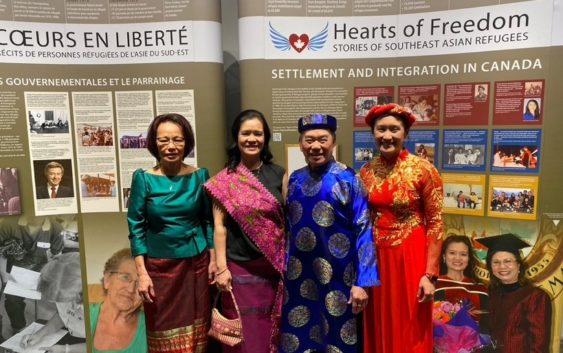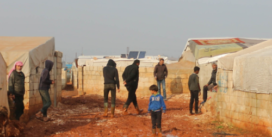- Fall Newsletter, 2025, Issue 15
- Using International Online Learning Modules to Engage Students in the Study of Critical Global Issues
- Upcoming Book Launch: Hearts of Freedom
- Announcing winners of the 2025 CARFMS Essay Contest
- The New York Declaration for Refugees and Migrants and its two Global Compacts: Addressing the Symptoms or the “Root Causes” of Forced Displacement?*
LESSONS LEARNED FROM THE INDOCHINESE REFUGEE MOVEMENT IN CANADA IN THE 1970s AND 1980s

Next year, 2025, will be a momentous year for all those in the field of refugees and forced migration studies. It marks the 50th anniversary of the fall of Saigon, now Ho Chi Ming City, in 1975, and the end of the Vietnam War. At the same time, 1975 marked the start of the Cambodian Genocide when the Communist Khmer Rouge deliberately instigated the death of some 2 million people, about one quarter of the population, through starvation, torture, execution, untreated diseases, forced marches, forced labour, medical experiments, and other forms of violence. Also, in 1975, the Communist Pathet Lao seized power and the Laotian Civil War that had been raging since 1959 came to an end. About one-third of the population of Laos fled to Thailand and the remaining population suffer brutal treatment at the hands of the Pathet Lao government, especially the ethnic minority Hmong who were trained by the CIA to fight against North Vietnam. The cumulative effect of the ending of the protracted wars in Indochina (Vietnam, Laos, and Cambodia) resulted in the mass exodus of millions of refugees that created one of the largest and longest refugee crises in history.
Canada’s response to the Southeast Asian (Indochinese) Refugee Movement was exceptional for several reasons. First, the Government of Canada introduced the Private Sponsorship of Refugees Program that allowed private organizations, associations, and even groups of five persons to sponsor refugee families to resettle in Canada. Second, the Canadian Government took the initiative to respond to the refugee crisis at its peak in 1979 to 1980 and resettled some 60,000 Southeast Asian refugees within a matter of about one-year: 26,000 government sponsored refugees and 34,000 private sponsored refugees. Third, Canadian citizens stepped up to respond to the refugee crisis in Southeast Asia with groups such as Mennonite Central Committee, Operation Lifeline, Project 4000, the Mennonite and Christian Reform Church, and many other groups. Fourth, there was a noticeable change among Canadians and their attitudes to welcoming refugees. All of this did not go unnoticed and, in 1986, the United Nations High Commissioner for Refugees (UNHCR) awarded the Nansen Medal to the people of Canada, the first and only time the Nansen Medal has been awarded to the people of a country, for their outstanding work in protecting refugees.
What lessons can we glean from the experience of the late 1970s and early 1980s in the protection of refugees and responding effectively to one of the most serious refugee crises in history? The following key lessons can be drawn from the Canadian response to the Southeast Asian refugee crisis in the late 1970s and throughout the 1980s.
- Protracted armed conflicts are the principal drivers of forced displacement. Clearly, 1975 was a pivotal year for the armed conflicts and severe human rights abuses and the death and destruction that were the consequences thereof that were taking place in Vietnam, Laos, and Cambodia. Mass forced displacement was the inevitable outcome with millions of people being forcibly displaced because of Communist Party takeovers and their harsh treatment of those who were perceived to be supporters of the opposing side. Many asylum seekers perished while en route to the countries where they were seeking refuge.
- Political Leaders must step up to take the humanitarian initiative in accepting large numbers of refugees. In 2023, resettlement in third countries accounted for less than one percent (0.36%) of the world’s 43.4 million refugees. Leadership must also be evident from civil society individuals and groups. The Canadian Private Sponsorship of Refugees program would not have been the remarkable success without politicians and civil society leaders who were prepared to organize their communities’ resources to protect those refugees who were fleeing severe human rights violations and abuses. Recognizing the fundamental human rights to those who are fleeing persecution and seeking refugee protection requires adherence and belief in the essential and universal human right to seek and receive asylum.
- Citizens must be encouraged to take up the cause of supporting refugees by participating in resettlement and settlement programs. The private sponsorship of refugees program requires organizations, associations, and groups of five people stepping forward to work and provide their time and financial support to bring those who have been forcibly displaced to resettle in Canada. This presupposes that citizens have a positive view of refugees and have a desire to provide humanitarian assistance to those in dire need of refugee protection.
- Government and private sponsorship initiatives for refugees have proven to be highly effective in expanding the number of refugees who are resettled in Canada. Government and private organizations, associations, and groups must work together to achieve their objective of welcoming as many refugees as reasonably possible to their new country. This requires close cooperation and collaboration between governments and those organizations, associations, and groups who want to sponsor refugees to resettle in Canada.
- Protracted armed conflicts or wars can constantly produce refugees. To effectively address refugee crises, you must be able to end wars and protracted armed conflict that force people to become refugees. This requires the good offices of the United Nations, along with the full support of all members of the UN, to end hostilities, and, if required, enforce a negotiated peace settlement. It also requires the full participation of civil society groups pressuring their governments to work toward achieving a ceasefire and then a negotiated peace settlement.
The Hearts of Freedom (HOF) national research project (see https://heartsoffreedom.org/), along with the Stories of Southeast Asian Refugees exhibition (curator – Stephanie Phetsamay Stobbe) and the Passage to Freedom documentary film (producer – Sheila Petzold), help to educate the Canadian public, at large, about the Southeast Asian Refugee Movement and all those who resettled in Canada from Vietnam, Laos, and Cambodia in the 1970s and 1980s, and through to the 1990s. The HOF Exhibition will be on display at the Osgoode Hall Law School Library, main entrance, York University, from September 13th to October 14th, 2024. The Passage to Freedom documentary film will be screened at the official opening of the HOF Exhibition at the Helliwell Centre, Osgoode Hall Law School, on Tuesday, September 24th, 10:00 am to 3:00 pm. The HOF exhibition and film screening are available at no cost. Everyone is welcomed to view the exhibition and the film screening.
The Hearts of Freedom – Stories of Southeast Asian Refugees exhibition and Passage to Freedom documentary film highlights the lives of those Southeast Asian refugees who were resettled in Canada. It provides an outstanding example of how Canadians have worked toward realizing the human rights of those who were forcibly displaced some 50 years ago from Southeast Asia and assisting them to resettle and resume their lives in Canada. Many of those who were resettled in Canada have enriched Canadian society and have gone on to extraordinarily successful careers across all fields, whether business, education, arts and culture, and sports. The creator and curator of the exhibition, Professor Stephanie Phetsamay Stobbe, Canadian Mennonite University, Winnipeg, Manitoba, will be at the official opening ceremonies on Tuesday, September 24th at the Helliwell Centre, Osgoode Hall Law School, York University, to discuss both the exhibition and the film, including the exhibition tour across Canada in museums, universities, libraries, city halls, government houses, Senate of Canada, and other venues. All are welcomed to attend.
For more information on the Hearts of Freedom exhibition, please contact Professor Stephanie Phetsamay Stobbe at hofmuseumexhibition@gmail.com.
Dr. James C. Simeon, York University
Dr. Stephanie P. Stobbe, Canadian Mennonite University
